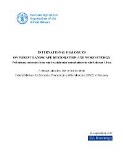From Restored Marginal Lands to Cooking Fuel – Links Between Wood Energy and Forest Restoration. Best Practices Presented During the 9th GBEP Bioenergy Week

Sustainable wood energy value chains benefit forest land restoration, and, parallelly, sustainable forest management fosters the production of biomass and wood energy. Such duality was the topic of the session on “Wood Energy and Land Restoration” hosted by the 9th GBEP Bioenergy Week in Paraguay (26-29 September 2022). Several examples and best practices were presented, highlighting the abundance of mutually beneficial interactions that may exist among wood energy and forest landscape restoration. For instance, plantations can be used to restore degraded lands or lands that cannot be used for agriculture, while being precious feedstock suppliers and providing other eco-system services. Indeed, fast-growing trees, so-called Short Rotation Woody Crops (SRWCs) such as poplars, willows, eucalypts or pines, are crops that provide biomass feedstock together with countless other economic and environmental benefits: SRWCs grow on marginal lands, sequestrate carbon and efficiently store it in the soil, may be harvested with little fertilization throughout the year, contribute to phytoremediation and improve soil tilth. In addition to their role within the wood energy value chain, Short Rotation Woody Crops have other applications that span over stormwater management, runoff reduction and groundwater recycling, while tackling the problems of degraded lands and waters.
On the other hand, not only the most attractive trees can be used as energy resources: forest biomass procurement may be integrated as a silvicultural tool for forest restoration by giving new life to discarded, degraded, or sick trees. Consider the case of Quebec, Canada, where wood supply is amazingly diverse, and sawmill quality standards very strict. The large volumes of wood left behind after quality screenings can be used to produce high quantities of biomass and bioenergy. Also sick trees and debris left on the ground after harvesting can be used as feedstock, and their removal improves the natural regeneration of the habitat and the growth of new stems. At the same time, the cost of regenerating a site without removal of degraded trees or residues exceeds that of site preparation with removal of debris. Thus, while being beneficial in terms of carbon balance when compared to other energy sources combined with usual forest degradation, such biomass procurement scenario serves as a silvicultural treatment to reduce plantation costs.
The above examples show the potential role that afforestation may play as a feedstock supplier to a sustainable wood energy value chain, while improving the surrounding eco-system. Generally, afforestation may remove up to 8.9 GtCO2 yearly, prevent desertification and supply food from areas and lands that cannot be used for agriculture, such as degraded land or mangroves. Moreover, the sustainable cycle of replanting forests harvested for woody biomass procurement can potentially remove between 0.5 and 11 GtCO2 per year, with an estimated cost of 15 to 400 USD/tCO2. In fact, on top of their supplying potential, forests represent a biological method for carbon sequestration, a fundamental activity in the bioeconomy, where sustainable conversion of bioenergy from biomass relies on CO2 capture and storage systems, both artificial as well as natural. For instance, carbon can be stored both below the ground in reservoirs, as well as into the soil in the form of bio-char, a product of thermal degradation of wood called pyrolysis. Such ‘natural’ CO2 storing system is beneficial to soil properties such as water and nutrient retention, aeration, and phosphorus availability. These contribute to plant health and growth, food security, immobilization of heavy metals and organic contaminants, reduced dependence on fertilisers and stabilization of new soil organic matter.
In addition to a feedstock supply and carbon capture and storage systems, a wood energy value chain based on a sustainable interplay of wood energy and land restoration has positive derivatives that integrate into the broader bioeconomy, such as green cooking: the use of upgraded biomass in gasification cookstoves as an alternative to open fires. This cooking technology employs pellets or briquettes derived from sustainable raw materials such as rice husks, nut shells, straw, sugar cane bagasse, elephant grass, and even from invasive bushes. In addition to being affordable and reducing smoke emissions while cooking, it decreases the need for charcoal, and consequently, deforestation for charcoal production. Green cooking represents a circular use of resources and by-products that are frequently unutilized. For example, most African countries produce more agricultural residues than needed to produce cooking fuel. All methods for green cooking fuel production (e.g. pelletization at processing mills, rural manufacturing of pellets or briquettes, or mobile pelletizers) create value from residues and support local economies.
The CGF PROEZA project in Paraguay is an example of an initiative that incorporates the duality among wood energy and forest restoration with the goal of strengthening social protection, promoting renewable energy consumption, and fuelling reforestation and production of feedstock. With this aim, among other measures, PROEZA promotes green cooking through the instalment of 7500 efficient kitchen stoves to reduce domestic use of wood while decreasing emissions and improving indoor air quality.
The instances presented during the “Wood Energy and Land Restoration” session are only a few of many tremendous cases of holistic approaches to combine wood energy and forest restoration in a mutually beneficial relationship that fosters the bioeconomy. Sustainable solutions to integrate forest management in wood energy supply chains are diverse, varying across regions and ecosystems, and rich in opportunities across the entire value chain. Developing on these practices benefits both the forest that supplied the raw materials used to produce bioenergy as well as its end-user, but requires increasing awareness, capacity building and enabling environments.


